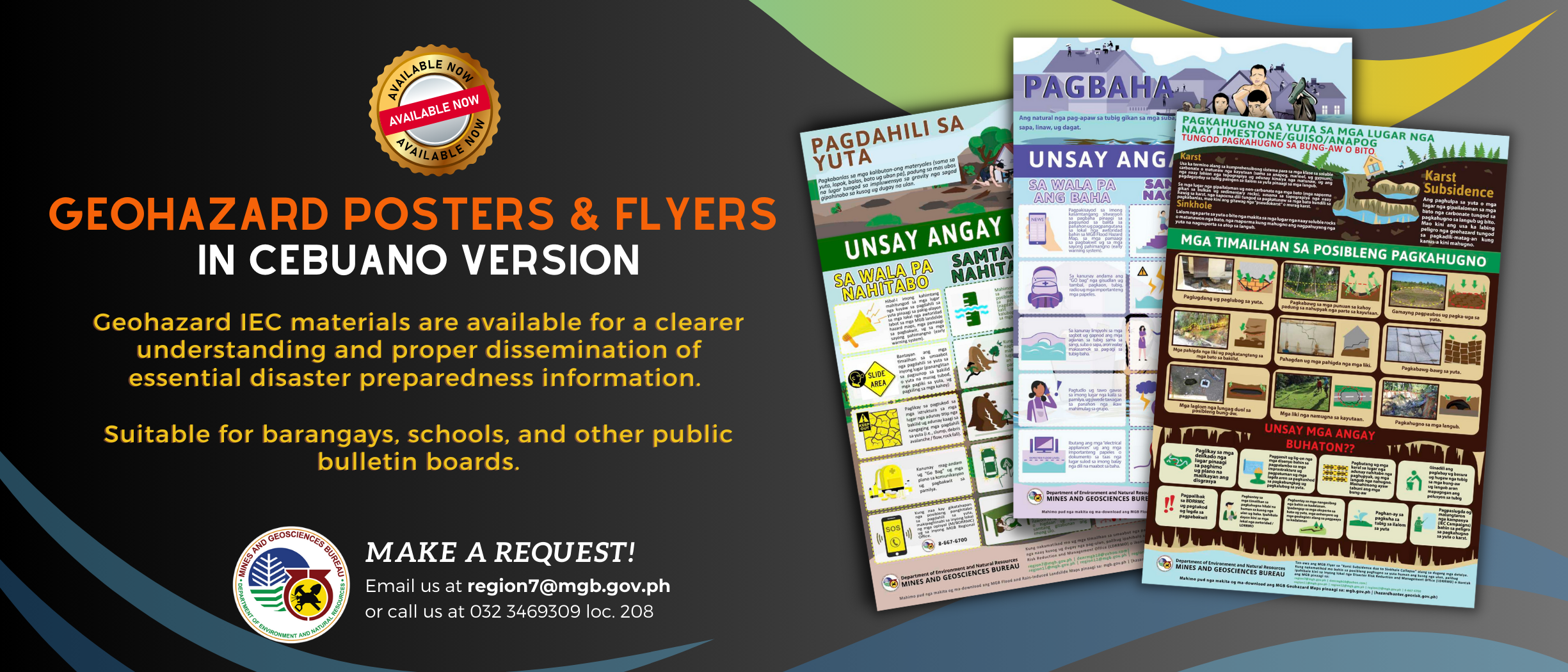The Department of Environment and Natural Resources (DENR) has reiterated its call to all local government units (LGUs) and the communities to seriously implement the ‘no habitation’ rule in critical and permanent danger zones identified by the Mines and Geosciences Bureau (MGB) to mitigate the effects of flashfloods and landslides.
The magnitude of destruction following the onslaught of Typhoon “Seniang” should be a wake up situation for the LGUs to make a careful review and revisit the geohazard maps provided by the MGB, said MGB 7 Regional Director Loreto B. Alburo.
The ‘no habitation’ policy includes areas which have been gravely affected by Typhoon “Seniang”.
Following a warning issued by the weather bureau on the magnitude of rains as a result of a low pressure area (LPA) spotted more than 1,000 kilometers away from the Philippine Area of Responsibility (PAR), the MGB 7 restated its geohazards threat advisories yesterday (January 14) to the four governors, 16 city mayors, and 116 municipal mayors in region 7.
In a letter-advisory signed by Alburo yesterday, it strongly urged the local chief executives to take whatever means is necessary to keep the communities away from harm as the LPA approaches.
“The rains that we experience now may intensify as the LPA comes over the weekend and we really have to be prepared at all times,” said DENR 7 Regional Director Dr. Isabelo R. Montejo.
He said the MGB has distributed to LGUs, down to the 3,003 barangays in four provinces in Central Visayas geohazard maps with a scale of 1:50,000 and other information, education and communication (IEC) materials like posters and compact discs (CDs).
“The said maps can also be viewed and downloaded free of charge on the websites of the DENR (www.denr.gov.ph), the MGB (www.mgb.gov.ph), the Philippine Information Agency (www.pia.gov.ph), and the Environmental Science for Social Change (www.essc.org.ph),” Montejo added.
On the MGB geohazard maps, landslide-prone areas are marked red and flood-prone areas are marked purple.
For this year, the MGB 7 aims to complete the geohazards assessment and mapping which is supportive to the Philippine Development Plan (PDP).
Montejo said strong political will among our local chief executives to enforce on those areas that have been identified as critical zones should remain to be inhabited.
“We should not be complacent as we are calling everyone to be “overprepared” as we don’t want to see casualties,” Montejo said.
Meanwhile, storm surge-prone areas are Arpili, Balamban; Tungkil, Minglanilla; Talisay, Maricaban, and Kinatarcan, all in Santa Fe; Tarong, Mancilang, and Codia, all in Madridejos; Patao and Pitogo in Bantayan; and Tanke in Talisay City.
Montejo warned the volume of water brought by Seniang might aggravate soil conditions that have been either saturated by rains even before its actual landfall.
Also, in Cebu City, 19 barangays are highly susceptible landslides, namely, Lusaran, Binaliw, Guba, Budlaan, Malubog, Buot-Taup, Busay, Sirao, Taptap, Tagbao, Tabunan, Pung-ol Sibugay,Sudlon II, Sudlon I, Sinsin, Buhisan, Pamutan, Sapangdaku, and Adlaon.
Barangays Tagjaguimit, Alpaco, Balirong, Mayana, Naalad, and Cogon in City of Naga.; 11 barangays in Balamban: Hingatmonan, Lamesa, Luca, Ginatilan, Cabasiangan, Matun-og, Cansomoroy, Gaas, Magsaysay, Cabagdalan, and Duangan.
Five barangays in Toledo City: Tungkay, Pangamihan, Bagacay, Loay and Don Andres Soriano; Lamac in Pinamungahan; Five barangays in Asturias:Agbanga, Baye, Bairan, Kanluangan and Sak-sak.
All mountain barangays in Talisay City, particularly, Manipis; Brgy. Doldol, Purok 3 in Dumanjug; and Cansalonoy in Ronda.
In Bohol, those portions of those areas which have been affected by the quake are advised to take the necessary precautions and to implement proactive evacuation are Tagbilaran City, Baclayon, Corella, Cortes, Alburquerque, Panglao, Dauis, Loon, Calape, Catigbian, Balilihan, Batuan, Sagbayan, and Carmen.
Alburo said the assessment reveals that there are five barangays in Cebu City that are considered to be most hazardous to flooding and these are Kasambagan, Kinasang-an, Labangon, Mabolo, Bonbon, and Cebu City downtown areas and along the Guadalupe River; and seven barangays in Mandaue City to include Subangdaku, Mantuyong, Umapad, Opao, Alang-alang, Guizo, and Pakna-an.
In Negros Oriental, five barangays in Guihulngan City, namely, Humayhumay, Imelda, Mabunga, Sandayao, and Tacpao have high susceptibility to landslides. There are 12 barangays with moderate to high susceptibility to landslide and these are Bakid, Banwaque, Calamba, Calupa-an, Linantuyan, Mabunga, Maniak, Plagatasanon, Planas, Trinidad, Binobohan, and Villegas.
In La Libertad, nine barangays with high landslide susceptibility are Aniniaw, Aya, Biga-a, Guihob, Kansumandig, Mambutod, Managondong, Pangca, and Pitogo. Barangay Mandapaton has moderate to high susceptibility to landslide. Eleven barangays with moderate susceptibility to landslide are Manluminsag, Busilak, Cantopa, Elecia (Talostos), Eli, Manghulyawon, Martilo, Nasungon, San Jose, Solongon, and Tala-on.
Around nine barangays in Bayawan City, namely Banga, Maninihon, Poblacion, Villareal, Nangka, Suba, Ubos, Pagatban and Kalumbuyan are flood-prone areas.
Also in Siaton, barangays Poblacion II, Poblacion III, Poblacion IV, and San Jose were flood-prone areas; and barangays Calicugan, Maloh, Cabangahan, Giliga-on, Bonawan and Apoloy area landslides-prone areas.
In Basay, the flood-prone areas are barangays near Tyabanan, Pagatban, and Basay rivers.
A total of eight barangays in Dumaguete City are flood-prone areas, namely, Candau-ay, Cadawinonan, Tabuctubig, Batinguel, Poblacion, Junob, Poblacion 2, and Bagakay.
In Siquijor, six barangays have been assessed to be highly susceptible to landslides and flooding and these are Libo in Enrique Villanueva; Bintangan, and Helen, in Larena; and Cang-isad, Luyang, and Sabang, in Siquijor.






